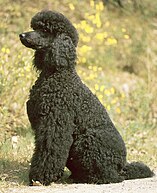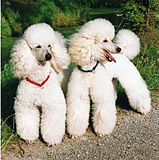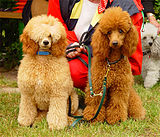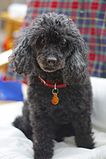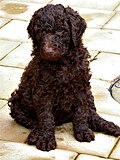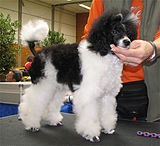Poodle
| Poodle | |||||||||||||||||
|---|---|---|---|---|---|---|---|---|---|---|---|---|---|---|---|---|---|
 | |||||||||||||||||
| Other names | |||||||||||||||||
| Origin | Germany or France (see history) | ||||||||||||||||
| |||||||||||||||||
| |||||||||||||||||
| Dog (domestic dog) | |||||||||||||||||
The Poodle, called the Pudel in German and the Caniche in French, is a breed of water dog. The breed is divided into four varieties based on size, the Standard Poodle, Medium Poodle, Miniature Poodle and Toy Poodle, although the Medium Poodle variety is not universally recognised. They have a distinctive thick, curly coat, and come in many colors, with only solid ones recognized by breed registries.
The Poodle most likely originated in Germany, although the Fédération Cynologique Internationale and a minority of cynologists believe it originated in France. The Standard Poodle was originally used by wildfowl hunters to retrieve game from water. The smaller varieties of the breed were bred from the original in France where they were once commonly used as circus performers, but have become popular companion dogs.
History
A majority of cynologists believe the Poodle originated in Germany, from a dog similar to today's Standard Poodle. It is claimed it was known in Germany from the Middle Ages, and it was Germany's water dog, just as England had the English Water Spaniel, France the Barbet, Ireland the Irish Water Spaniel and the Netherlands the Wetterhoun.[1][2][3][4][5] Among the evidence used to support this theory is the Germanic name for the breed, Poodle or "Pudel" in German, which is derived from the Low German word "puddeln", which means "to splash". Numerous works by various German artists from as early as the 17th century depict dogs of recognisably Poodle type.[1][2][3][5] Some cynologists believe the Poodle originated in France, where it is known as the "Caniche" (French for "duck dog"), and that the breed descends from the Barbet. This view is shared by the Fédération Cynologique Internationale (FCI).[6][7] Others argue that the breed originated in Russia, Piedmont or Northwest Africa.[4][7]
Whatever the Poodle's country of origin, both their German and French breed names indicate the modern Poodle's ancestors were widely used by waterfowlers both to retrieve shot game and to recover lost arrows and bolts that had missed their mark.[3][4]
Size variants
Due to their intelligence, obedient nature, athleticism and looks the Poodle was frequently employed in circuses, particularly in France.[2][3][5][7] In French circuses the breed was selectively bred down in size to create what is now known as the Miniature Poodle, which was known as the Toy Poodle until 1907, as a smaller sized dog is easier to handle and transport in a travelling circus.[5] As circus performers the variety was frequently seen performing all manner of tricks including walking tightropes, acting out comedies and even performing magic and card tricks. Outside of the circus the variety was to become an extremely popular companion dog.[2][3][5]
The Toy Poodle was created at the beginning of the 20th century when breeders again bred the Miniature Poodle down in size to create a popular companion dog.[2][3][5] Initially, these efforts were not entirely effective, and disfigured or misshapen pups, as well as pups with behavioural problems, were seen frequently, as a result of irresponsible breeding for dwarfed size only. As time progressed, and new breeding practices were adopted, the variety became set as a toy sized replica of the original.[2][3][5] Later attempts to create an even smaller variety, the Teacup Poodle, were unable to overcome serious genetic abnormalities and were abandoned.[5]
The last of the Poodle varieties to be recognised was the Medium Poodle, which in size is mid way in between the Standard and the Miniature Poodle. Not universally recognised by the world's kennel clubs, the Medium Poodle is recognised by the FCI and most Continental European kennel clubs.[3][5][6] One of the reasons for creating this fourth size variety is believed to be a desire to reduce the number of entries of Poodles by variety at conformation shows.[5]
Recent history
The Poodle was recognised by the Kennel Club of the United Kingdom in 1874, and by the American Kennel Club (AKC) in 1886, soon after the founding of both clubs.[8] In the United States, poodles were unpopular until 1935, when the Poodle Champion Nunsoe Duc de la Terrace won best in show at Westminster. Afterwards, they rapidly gained prominence, becoming the most popular breed from 1960 to 1982.[9][10] Since 1935, Poodles have won best in show at Westminster 10 times, the second-most of any breed.[11] As of 2012, the Poodle was the third-most popular FCI registered breed worldwide, after the Labrador Retriever and German Shepherd, with 118,653 new dogs registered per year from the 25 countries surveyed.[12]
Description
Appearance
The Poodle is an active, athletic breed with the different varieties differing mostly by their size.[1][2][3] The FCI's breed standard states the Standard Poodle stands between 45 and 62 centimetres (18 and 24 in), the Medium Poodle between 35 and 45 centimetres (14 and 18 in), the Miniature Poodle between 28 and 35 centimetres (11 and 14 in) and the Toy Poodle 24 and 28 centimetres (9.4 and 11.0 in).
The kennel clubs which do not recognise the Medium Poodle variety typically have the Standard Poodle between 38 and 60 centimetres (15 and 24 in) and Miniature Poodle between 28 and 38 centimetres (11 and 15 in), with the toy variety remaining unchanged.[3][5][6]
A healthy adult Standard Poodle typically weighs between 20 and 32 kilograms (44 and 71 lb), a Medium Poodle between 15 and 19 kilograms (33 and 42 lb), a Miniature Poodle between 12 and 14 kilograms (26 and 31 lb) and a Toy Poodle between 6.5 and 7.5 kilograms (14 and 17 lb).[3]
Coat
Poodles have thick, curly coats with harsh fur. A pet owner can anticipate grooming a Poodle every four to eight weeks.[13]
Poodles are often cited as a hypoallergenic dog breed. Their individual hair follicles have an active growth period that is longer than that of many other breeds; combined with the tightly curled coat, which slows the loss of dander and dead hair by trapping it in the curls, an individual Poodle may release less dander and hair into the environment. However, researchers have generally not found a difference in allergens across breeds.[14][15][16]
Clips and grooming
Over 50 different styles of coat clips are recognised for the Poodle. The most popular in the show ring is the Continental clip, where the face and rear end of the body are clipped, leaving tufts on the hocks and tip of the tail and rosettes on the hips.[5] A similar clip was historically used to prevent the poodle from getting weighted down by their fur when swimming to retrieve a bird, while still leaving their joints and vital organs covered.[11] Pet poodles are most often clipped evenly over their entire body, with the face and paws cut shorter. This is known as the sporting clip.[17]
In most cases, whether a Poodle is in a pet or show clip, the hair is completely brushed out. Poodle hair can also be "corded" with rope-like mats similar to those of a Komondor or human dreadlocks. Though once as common as the curly Poodle, corded Poodles are now rare. Corded coats are difficult to keep clean and take a long time to dry after washing. Any Poodle with a normal coat can be corded when its adult coat is in. Corded Poodles may be shown in all major kennel club shows.[6][17][18]
Colours
The Poodle has a wide variety of colouring, including white, black, brown, blue, gray, silver, café au lait, silver beige, cream, apricot, and red, and patterns such as parti-, abstract, sable, brindle and phantom. Recognized FCI colourations are black, white, brown, gray, and fawn (apricot and red before 2015).[19] Recognition of multi-colored Poodles varies by registry. They were common historically, but became less popular in the early 1900s, and are excluded from many registries.[20] The American Kennel Club (AKC) recognizes Poodles in either solid-coloured and multi-colored coats; however, only solid-colored poodles may compete in conformation.[17]
A parti-Poodle has patches of any accepted solid colour over a white coat. The coat will usually be white and coloured in equal amounts, though it can vary as long as the coat is at least half white.[21] When a parti-coloured Poodle has markings that resemble those of a tuxedo, it is called a "tuxedo" Poodle. The upper coat is solid black: head, back, tail; and the lower coat is white: neck, chest, abdomen, and legs, making up usually 40% or more of the coat. An abstract Poodle is primarily solid-coloured, with patches of white.[22]
Phantom Poodles have a solid main color with a lighter colour appearing on their "eyebrows", muzzle and throat, legs and feet and below their tail. Like Dobermans, phantom Poodles often have either a black or brown main coat with tan (usually apricot or red) lighter colourings around the eyebrows, muzzle, throat, legs, feet, and below their tail. Phantom Poodles may also have a full face of the secondary color.[21]
Temperament
Poodles are a highly intelligent, energetic, and sociable breed. A 1994 study by Stanley Corey ranked them second out of 110 breeds in intelligence.[23] They are an active dog, requiring regular physical and intellectual activities.[24] Shyness or sharpness is considered a serious fault in the breed.[25] Though not suitable as a guard dog because it is neither a territorial breed nor particularly aggressive, Poodles tend to be protective of their families and are good with children.[24]
Health
The Poodle Health Registry lists over 50 major health disorders of Standard Poodles.[8] Overall, the Poodle is a comparatively healthy breed, and there are no Poodle-specific health problems. Nevertheless, they suffer from a number of hereditary diseases due to inbreeding. One study estimated that two average Standard Poodles are about as closely related as the offspring of two full sibling village dogs.[26]
Some of the worst common hereditary poodle diseases are the skin disease sebaceous adenitis (estimated prevalence 2.7%) and Addison’s disease, an endocrine system disorder. Both diseases became more prevalent in poodles after the 1960s burst in poodle popularity led to rapid careless breeding aimed at producing good show dogs.[26][8]
Poodles have a life expectancy of 10-18 years, with the Standard Poodle, like most large dogs, tending to be more short-lived.[24][13]
Work and sport
Poodles were originally breed for waterfowl hunting.[19] Despite this history, they are currently classified as companion dogs by the FCI.[19] Since the late 1980s, some breeders in the United States and Canada have been selecting for dogs with drive for birds in order to revive the breed for hunting, with some success.[27] Poodles are highly trainable dogs that typically excel in obedience training.[24] Historically, they were a popular circus dog. In addition to hunt tests, they do well in agility and rally.[11] They are among the most popular service dog breeds.[28]
Poodles have been used as working dogs in the military since at least the 17th century, most likely because of their highly intelligent, trainable nature and background as a hunting dog making them suitable to battlefields, as evidenced by their ability to be trained to ignore gunfire. During the English Civil War, Prince Rupert of the Rhine had a famous hunting Poodle who would ride into battle with his master on horseback. Napoleon Bonaparte wrote in his memoirs about the faithfulness of a grenadier's pet Poodle who stayed with the body of his master at the Battle of Marengo.[29]
See also
References
- ^ a b c Alderton, David (1987). The dog: the most complete, illustrated, practical guide to dogs and their world. London: New Burlington Books. pp. 87–88. ISBN 978-0-948872-13-6.
- ^ a b c d e f g Alderton, David (2008). The encyclopedia of dogs. Bath: Parragon Books Ltd. pp. 131 & 354. ISBN 978-1-4454-0853-8.
- ^ a b c d e f g h i j k Fogle, Bruce (2009). The encyclopedia of the dog. New York: DK Publishing. pp. 68–69, 190 & 282. ISBN 978-0-7566-6004-8.
- ^ a b c Hancock, David (2013). Gundogs: their past, their performance and their prospects. Ramsbury, Marlborough: The Crowood Press Ltd. pp. 33 & 37–38. ISBN 978-1-84797-492-1.
- ^ a b c d e f g h i j k l Morris, Desmond (2001). Dogs: the ultimate dictionary of over 1,000 dog breeds. North Pomfret, VT: Trafalgar Square Publishing. pp. 295–297 & 526–529. ISBN 978-1-57076-219-2.
- ^ a b c d "FCI-Standard N° 172: Poodle" (PDF). Fédération Cynologique Internationale. 23 January 2015. Retrieved 21 March 2021.
- ^ a b c Fiorone, Fiorenzo (1973). The encyclopedia of dogs: the canine breeds. New York: Thomas Y. Cromwell Company. pp. 377–381. ISBN 978-0-690-00056-6.
- ^ a b c Pedersen, N. C.; Liu, H.; McLaughlin, B.; Sacks, B. N. (18 April 2012). "Genetic characterization of healthy and sebaceous adenitis affected Standard Poodles from the United States and the United Kingdom". Tissue Antigens. 80 (1): 46–57. doi:10.1111/j.1399-0039.2012.01876.x. ISSN 0001-2815. PMID 22512808.
- ^ Rice, Berkeley (7 January 1968). "Poodles really like people: The most popular dog in America". New York Times.
- ^ "AKC Registration Statistics Fact Sheet". Archived from the original on 13 April 2011.
- ^ a b c Flaim, Denise. "The Poodle Paradox: History Behind a Haircut". American Kennel Club. Retrieved 3 April 2022.
- ^ "Registration figures worldwide – from top thirty to endangered breeds". DogWellNet. Retrieved 20 February 2022.
- ^ a b Guidry, Virginia Parker (5 May 2010). Your Poodle's Life: Your Complete Guide to Raising Your Pet from Puppy to Companion. Crown. ISBN 978-0-307-54998-3.
- ^ Nicholas, Charlotte E.; Wegienka, Ganesa R.; Havstad, Suzanne L.; Zoratti, Edward M.; Ownby, Dennis R.; Johnson, Christine Cole (2011). "Dog allergen levels in homes with hypoallergenic compared with nonhypoallergenic dogs". American Journal of Rhinology & Allergy. 25 (4): 252–256. doi:10.2500/ajra.2011.25.3606. ISSN 1945-8924. PMC 3680143. PMID 21819763.
- ^ Grady, Denise (5 February 1997). "Nonallergenic Dog? Not Really". The New York Times. Archived from the original on 30 January 2009. Retrieved 21 April 2011. How hypoallergenic the dog is may vary with the individual dog and the individual person.
- ^ Bakalar, Nicholas (11 July 2011). "The Myth of the Allergy-Free Dog". New York Times. Retrieved 20 February 2022.
- ^ a b c "Poodle". American Kennel Club. Retrieved 7 February 2021.
- ^ "United Kennel Club: Standard Poodle Breed Standard. Retrieved May 12, 2007". Archived from the original on 11 November 2006.
- ^ a b c "FCI-Standard N° 172 - Poodle (Caniche)" (PDF). Fédération Cynologique Internationale.
- ^ "Multi-Colored Poodle History". United Poodle Association. 29 March 2018. Retrieved 9 April 2022.
- ^ a b Ewing, Susan M. (4 May 2011). Poodles For Dummies. John Wiley & Sons. ISBN 978-1-118-06812-0.
- ^ "Poodle Coat Colors". United Poodle Association. 5 February 2018. Retrieved 9 April 2022.
- ^ Coren, Stanley (1994). The intelligence of dogs : a guide to the thoughts, emotions, and inner lives or our canine companions. New York: Free Press. ISBN 978-0-7432-8087-7. OCLC 61461866.
- ^ a b c d "Poodle Dog Breed Information". American Kennel Club. Retrieved 20 February 2022.
- ^ "AKC Breed Standard". The Poodle Club of America. Retrieved 20 February 2022.
- ^ a b Pedersen, Niels C.; Brucker, Lynn; Tessier, Natalie Green; Liu, Hongwei; Penedo, Maria Cecilia T.; Hughes, Shayne; Oberbauer, Anita; Sacks, Ben (27 August 2015). "The effect of genetic bottlenecks and inbreeding on the incidence of two major autoimmune diseases in standard poodles, sebaceous adenitis and Addison's disease". Canine Genetics and Epidemiology. 2 (1): 14. doi:10.1186/s40575-015-0026-5. ISSN 2052-6687. PMC 4579369. PMID 26401342.
- ^ "Poodles ready to hunt". Denverpost.com. 19 February 2008. Archived from the original on 11 December 2014. Retrieved 11 December 2014.
- ^ Bauhaus, Jean (15 July 2021). "Most Popular Service Dog Breeds". American Kennel Club. Retrieved 20 February 2022.
- ^ Cawthorne, Nigel (2012). Canine Commandos: The Heroism, Devotion, and Sacrifice of Dogs in War. Ulysses Press. ISBN 978-1-61243-055-3.
External links
 Media related to Poodle at Wikimedia Commons
Media related to Poodle at Wikimedia Commons
- Articles with short description
- Use British English from March 2021
- Use dmy dates from September 2015
- Articles containing German-language text
- Articles containing French-language text
- Articles with 'species' microformats
- Commons link is defined as the pagename
- Toy dogs
- AC with 0 elements
- Companion dogs
- Dog breeds originating in France
- Dog breeds originating in Germany
- FCI breeds
- Gundogs
- Water dogs

